Estepona, the Garden City of the Costa del Sol in Malaga province, Andalucia, Spain, renowned for its floral displays, murals and sculptures
By Nick Nutter | Updated 1 Aug 2023 | Málaga | Villages |
Login to add to YOUR Favourites or Read Later
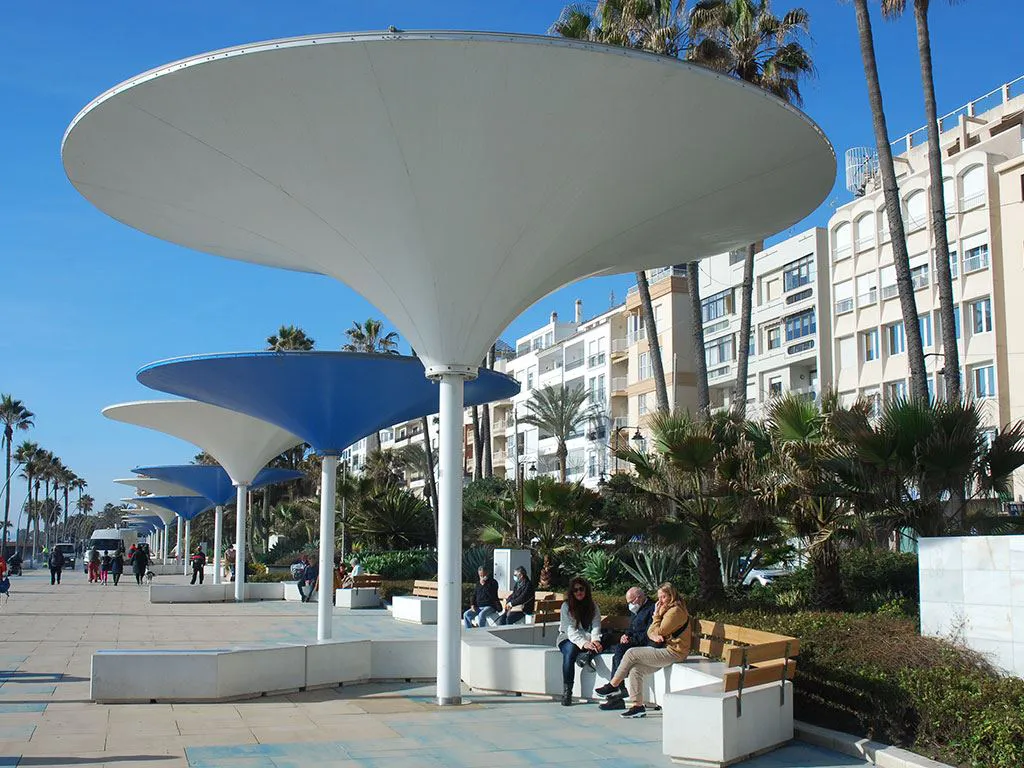
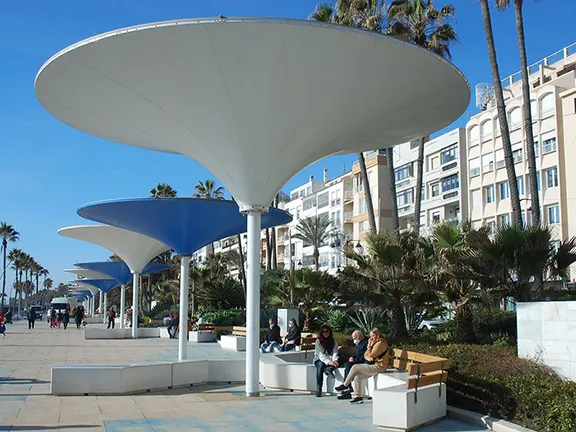
Estepona paseo
Estepona has long been a favourite seaside resort for Spanish families. Every August the town’s population multiplies with an influx of people escaping the torrid heat of the inland cities of Spain. They arrive from Madrid, Seville, Cordoba, Jaen and Granada. The town is also home to an ever-increasing number of expatriates from northern Europe and is increasingly seen as a holiday destination by tourists from Britain, Scandinavia, Germany, Holland and eastern European states.
So why is Estepona becoming a favourite destination? Why has this previously unremarkable, and unremarked upon, town become so popular? What does the first-time visitor to Estepona see in the town?
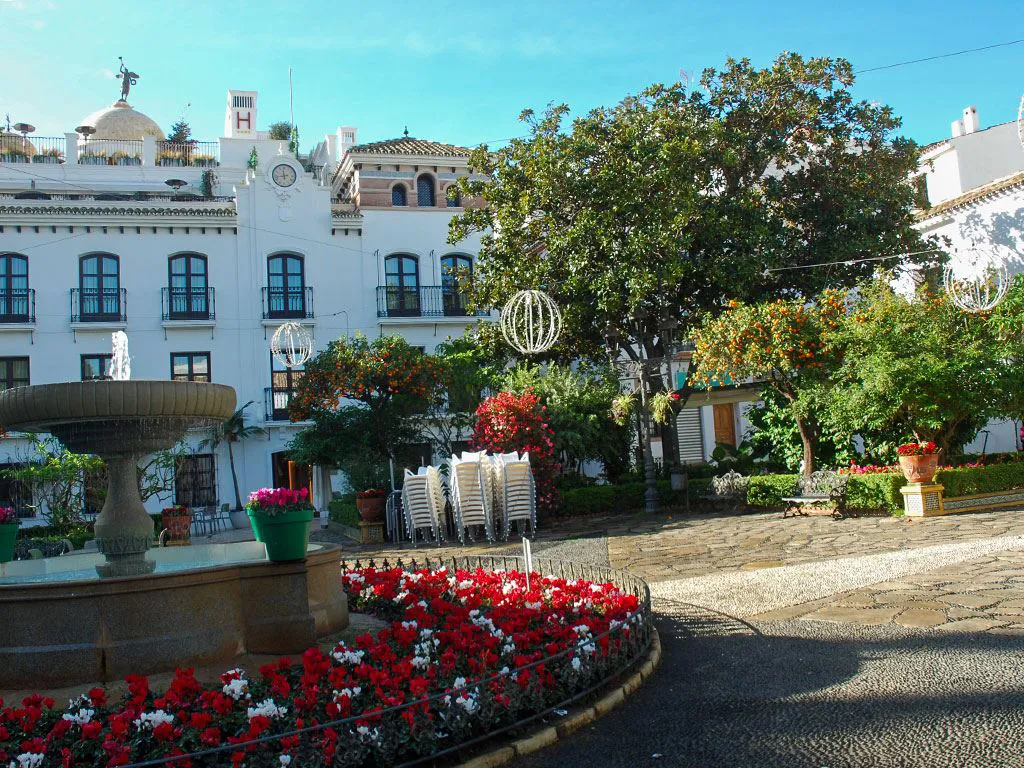
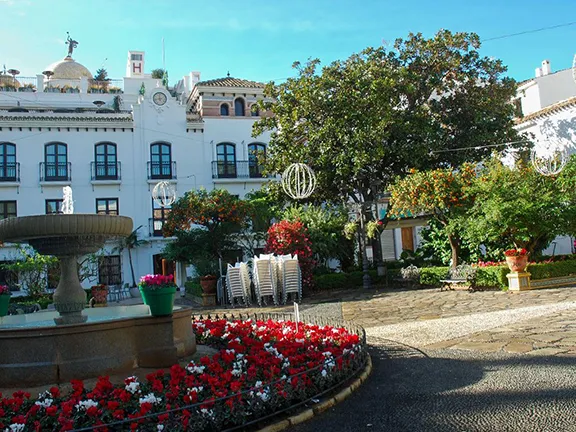
Plaza de Flores
Estepona’s location helps. It is on the Costa del Sol about one hour away from Malaga airport, just far enough away to put it outside the package tour zone, and about 45 minutes from Gibraltar, which has never been a package tour airport, unless the destination was Gibraltar itself. A lack of demand for high rise hotels has been a blessing; there are none. Estepona is certainly not a Benidorm in that respect. There are a couple of new hotels being built in the centre of town (2019) but even they do not soar above the existing rooftops. Hotels on the outskirts also tend to be low rather than high rise, and well separated from one another.
Visitors to Estepona town arrive by road, they have little choice. That the road happens to be the old Roman Via Augusta is lost on most people. Whether driving in from the east or west, with the blue Mediterranean always in view, the first impression is colour. Entering town the road has central reservations and wide, tree-lined verges, all packed with flowers. An abundance of trees and palms, throughout the town, not just on its approaches, provide shade for humans and nesting sites for parrots as well as sparrows. The buildings are predominantly white, particularly in the old part of town, with red, tiled roofs. Very Roman-like.
Mentioning the Romans, Estepona’s written history does not seem to extend that far back in time. The Romans were undoubtedly in the town and there is still a dispute about the name of their settlement. It could have been Salduba or Silniana, nobody is sure.
A Roman cemetery, in use between the 1st and 3rd centuries AD has been found in Calle Villa, a few hundred metres east of the town centre. In the older part of town, now preserved, are the remains of an octagonal-shaped mausoleum that dates to the 4th century AD, right at the end of the Roman period. It was in use for 200 years, through the Visigothic occupation, until the start of the Byzantine period in the 6th century AD. The Moors arrived in 711 AD but we have to wait until the 10th century before there is any written record of the place.
About 1 kilometre east of Estepona town centre, on the seaward side, just past Carrefour supermarket is a small aqueduct. Still in use, the arches are from the Moorish period. However, the pillars and foundations are Roman. What makes this ancient aqueduct interesting is that it is still working. A well at one end sinks 3 meters into the ground. Today water is pumped from the spring by an electric motor, originally it would have been donkey power. The water travels down the aqueduct to a well from which the surrounding smallholdings are irrigated. There are still old orange and fig trees growing on this patch of land. The second interesting item is a name inscribed on the aqueduct, Saladavieja. Was that the Roman name for the settlement at Estepona?
It transpires that the Moors called the town Astabbuna and it is from this name that Estepona derives. They built a mosque, complete with a minaret, and there was a small settlement. According to a later text, written in the 14th century, Astabunna was known for its delicacies, a reference to the salted fish and garum presumably produced nearby. A hundred years later, in 1457, Astabunna was taken by the Christians. They immediately set about demolishing and burning anything not already destroyed in the siege and then, in 1458, started to build a church and castle around which the modern town of Estepona grew.
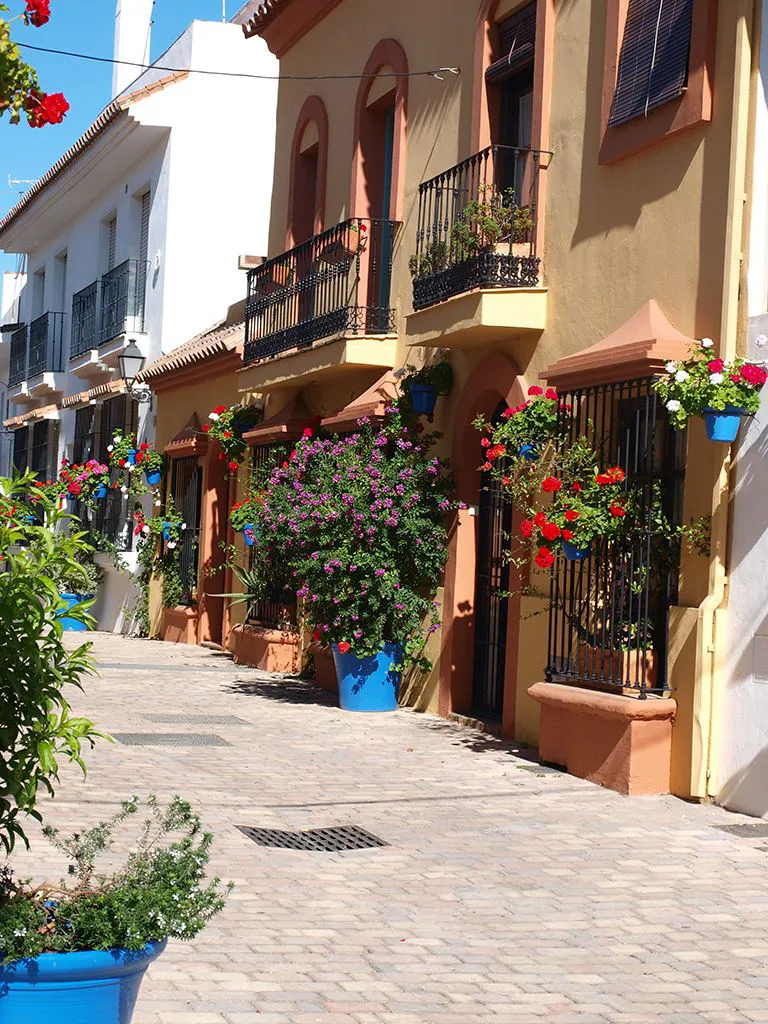
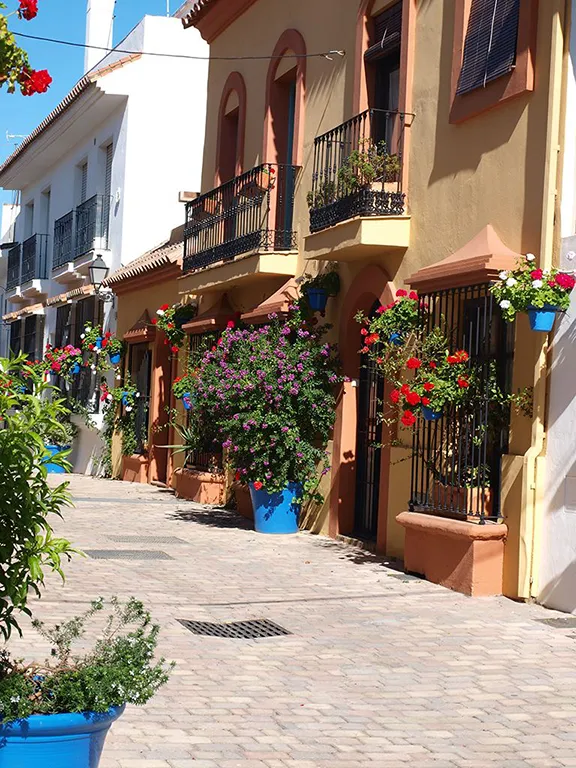
The first time visitor to Estepona is very likely going to explore the old part of town. It’s easy enough to find. Just head up to either the emblematic church tower with its distinctive blue and white tiled roof or the clock tower nearby, La Torre del Reloj.
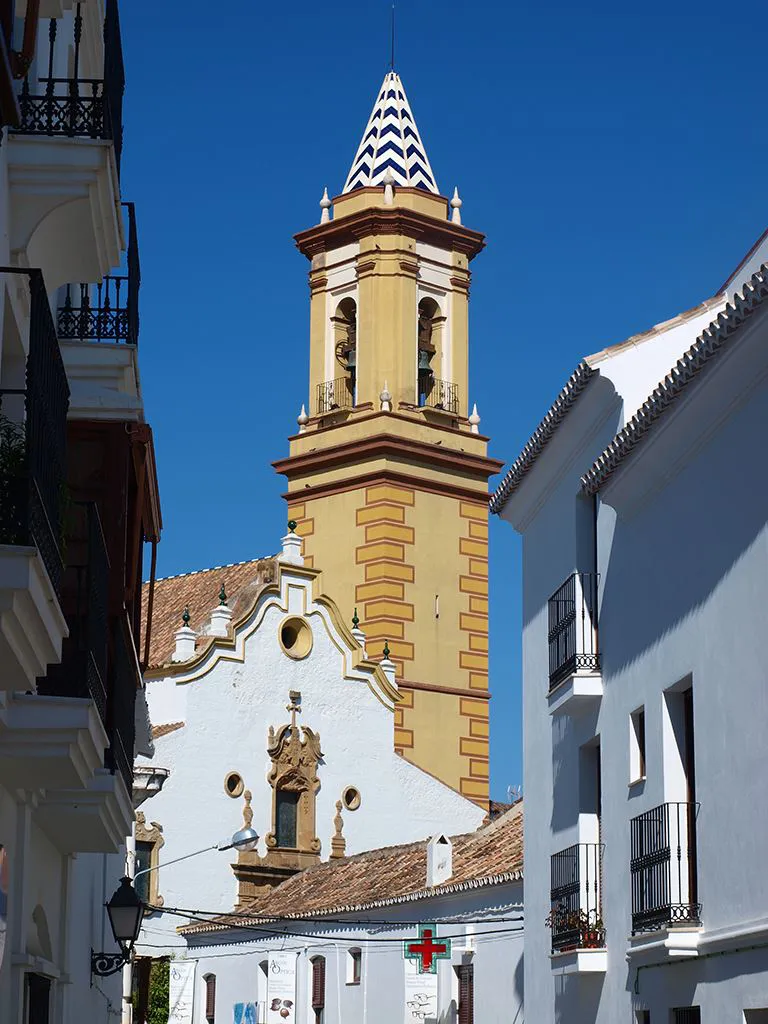
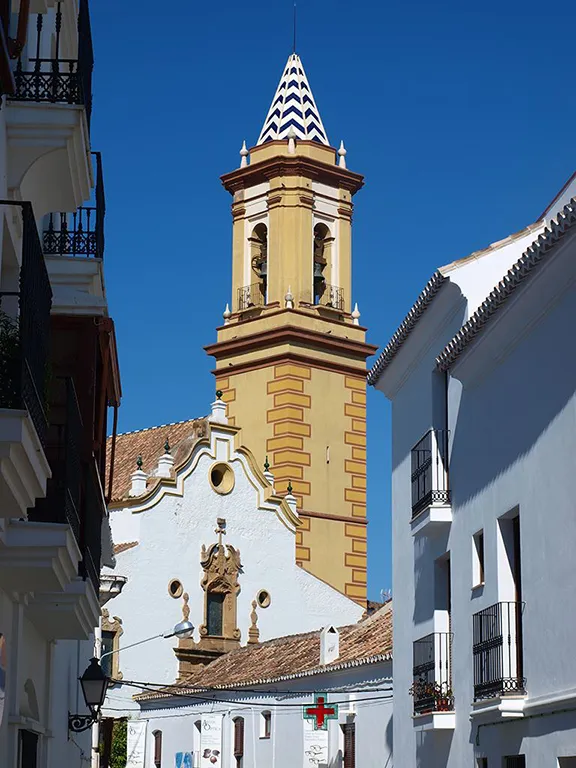
The Torre del Reloj is the only visible reminder of the original church that was completed in 1473. The tower was built around the minaret erected by the Moors whilst the body of the church replaced the mosque. The dome on top of the tower is an 18th-century addition. It is the oldest ecclesiastical building on the Costa del Sol.
The clock tower stands above a square, Plaza del Reloj, at the southern end of which is the now preserved remains of the Roman mausoleum. Less than 30 metres south again you will see the remains of a castle.
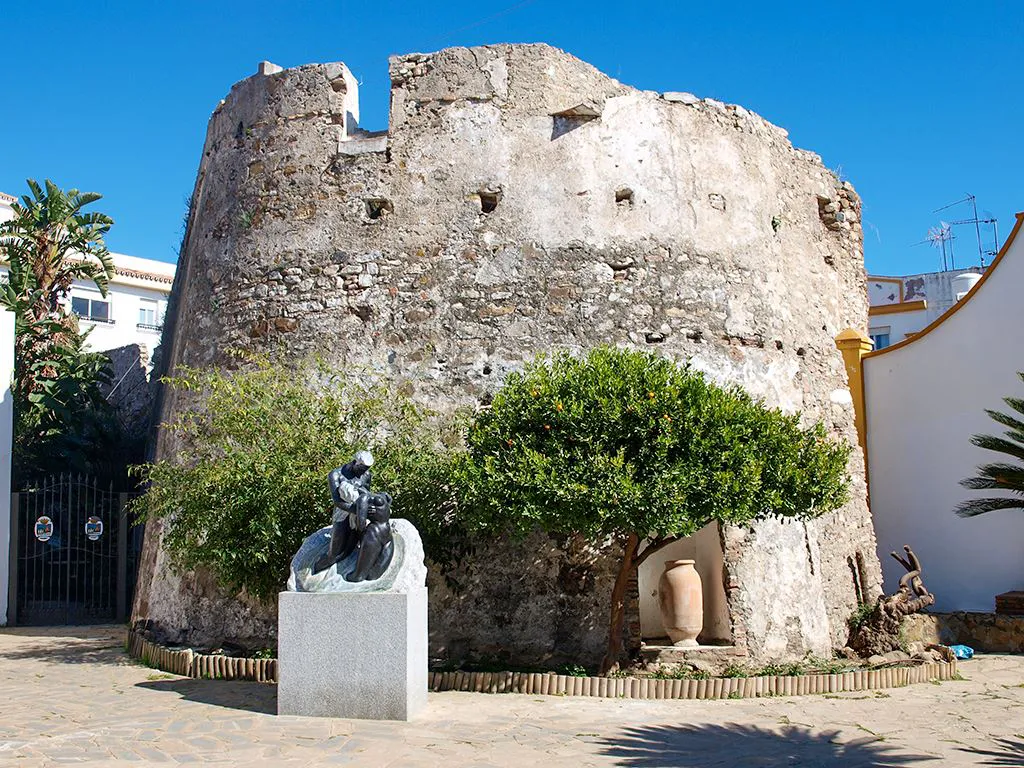
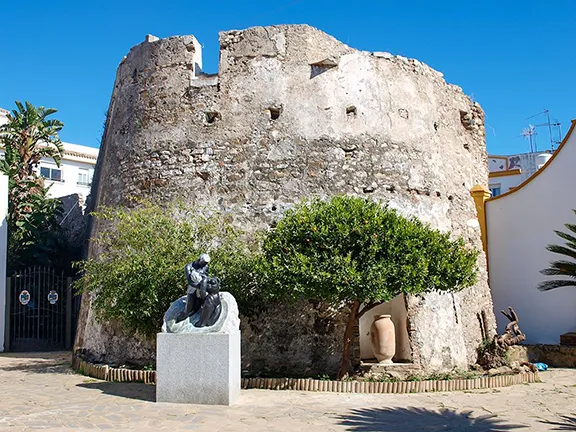
Castillo de San Luis
Castillo de San Luis was started around 1500 AD. Its original purpose was to defend the emerging settlement from that curse of the coast, the Barbary pirates. Only part of a tower and a short section of the wall now survive, the rest has been subsumed into the later buildings.
In 1502 it was recorded that Estepona consisted of only 25 families. The hundred years following the construction of the protective castle saw the area surrounding the church and castle expand, populated by immigrants from northern Spain encouraged to settle to repopulate the area.
By the 18th century, the town was ready for its second ecclesiastical building, a Franciscan monastery, the hermitage of Vera Cruz. It was built less than a hundred metres north of the clock tower. The hermitage became a hospice and finally, towards the beginning of the 19th century, the church of Nuestra Señora de Los Remedios. It is a curious mix of styles that has been described as American colonial and rococo. Its rather charming, certainly unusual, particularly with its blue and white tiled, hexagonal, steeple. The church is built out of the local iron-rich sandstone, notice the lumps of hematite, iron ore, still protruding from the stone.
The three buildings, the church, the clock tower and the castle form the core of the old town. Surrounding them are the typical narrow, winding, white streets of an Andalucian town. Even here you will find flowers. In 2013 and 2014 money was provided to allow the local council to erect and maintain hundreds of hanging and wall baskets throughout the old town. The local householders, many of whom already had colourful displays, joined in the spirit of the time and the result is truly spectacular. Estepona has become known as the 'Garden City of the Costa del Sol'.
It is not just flowers in the old town. Tucked away down the side streets you will find small, family-run shops that have been in the family for generations. Some are little more than living rooms entered via the front door. Fresh vegetables, bread, fish and meat, clothes and electrical goods can all be obtained from these tiny establishments that have held out against the threat of the supermarkets. Of similar size are the tabernas and bodegas in which you can refresh yourself with a wine or beer and tapas. There are also patisseries and restaurants, many little larger than the bodega, serving excellent pastries, coffee and local produce.
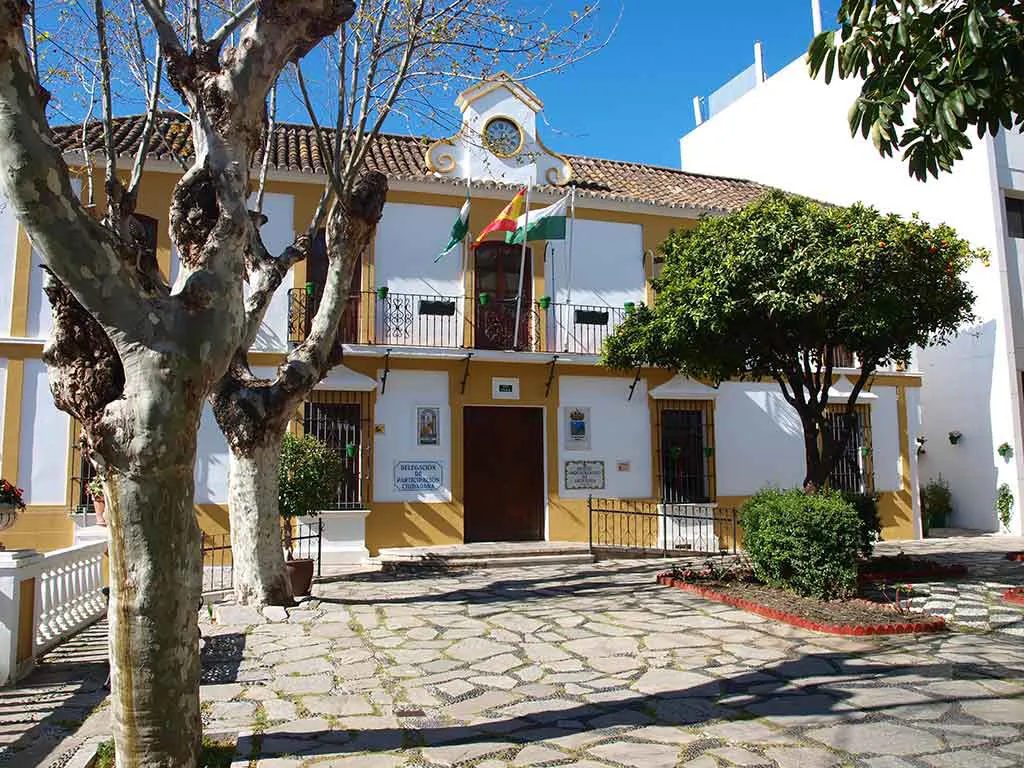
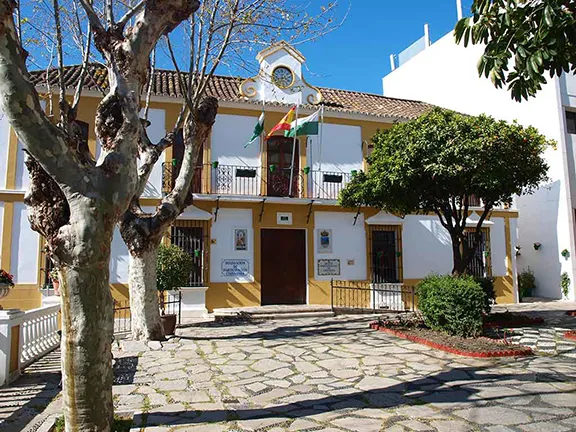
Estepona Archaeoligical Museum
For those wanting to know more about the history of Estepona, there is a small archaeological museum in Plaza Blas Infante, just to the west of the clock tower.
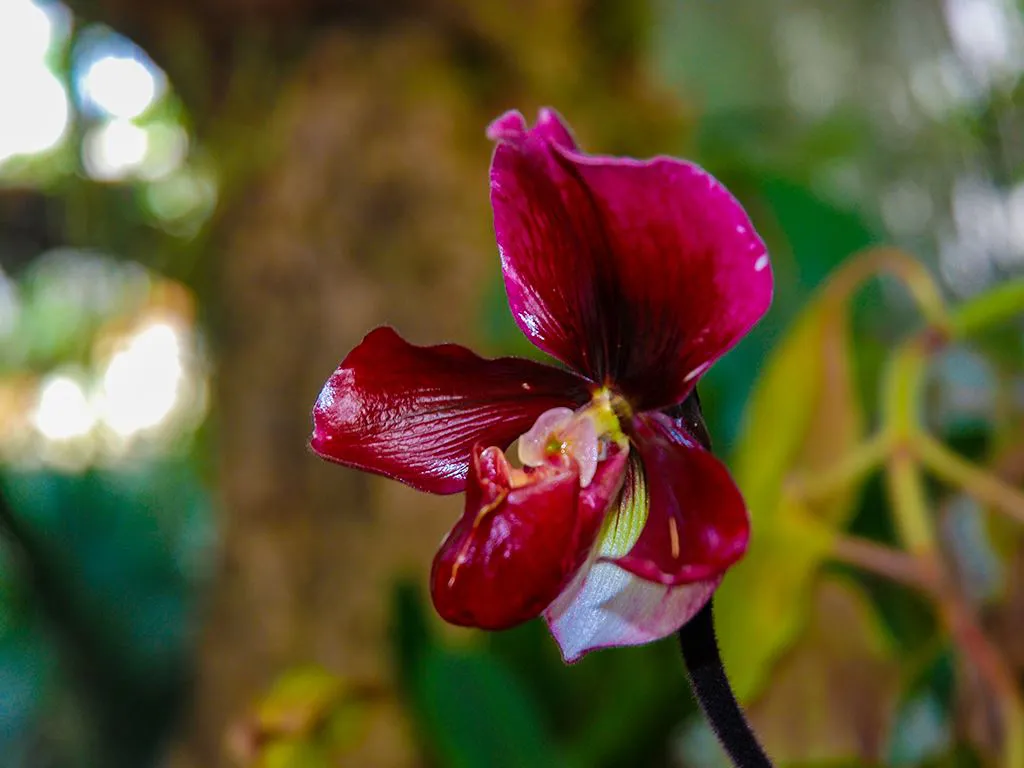
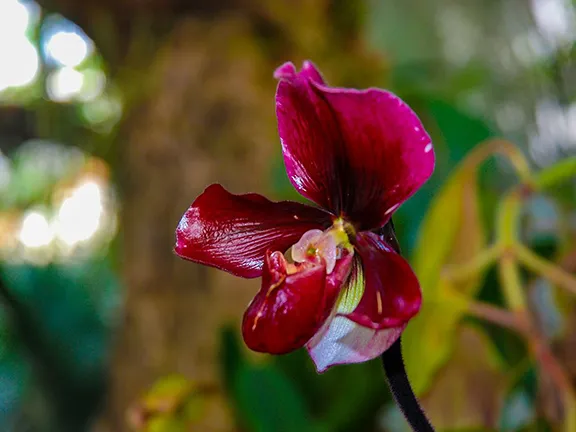
In 2015, Estepona decided to capitalise on its growing reputation as the 'Garden City of the Costa del Sol'. The year saw the opening of an orchidarium. Three glass domes rise above the rooftops. They house a collection of over 4,000 orchids from Asia and South America. Since its opening the orchid house has gained an international reputation and hosts conferences and exhibitions.
Click here to learn more about the Orchid House in Estepona.
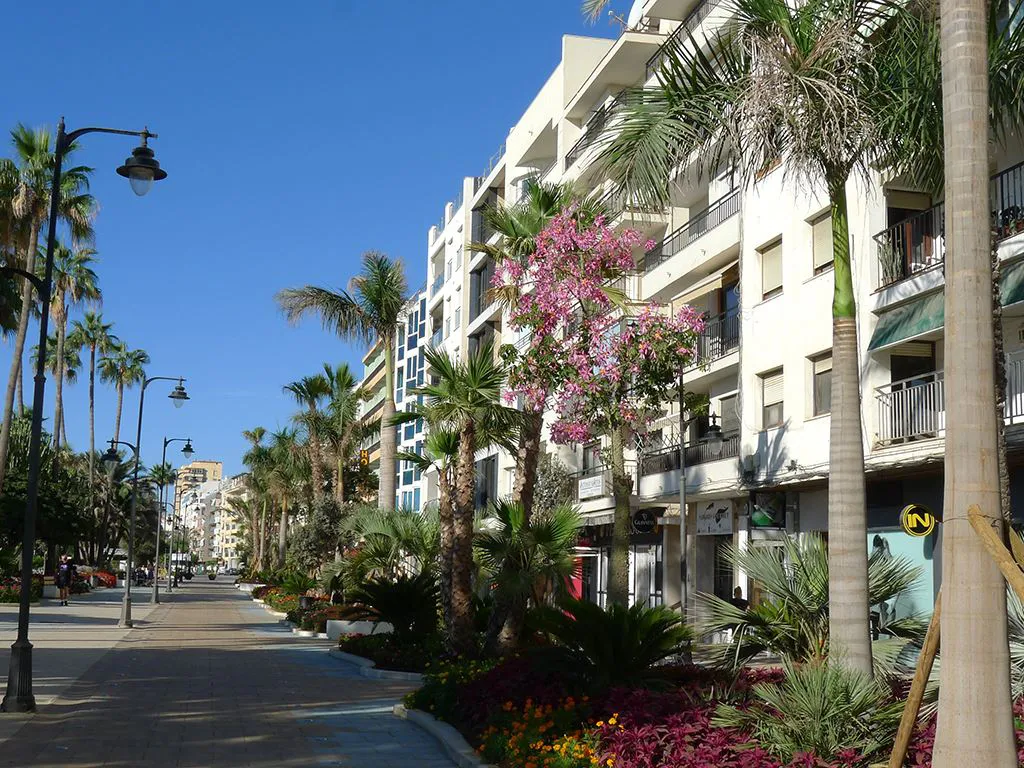

Estepona Paseo - Image by Philip Crawford
Visitors inevitably find themselves on the 1.5-kilometre long pedestrianised paseo behind La Rada beach. The wide paseo itself is a thing of beauty, its tiled walkway is interspersed with water features and artistically arraigned canvas awnings for shade. There is a continuous belt of wide flowerbeds with a variety of planting schemes from cool green shade-loving plants to palm trees and plants that thrive in arid climes, interspersed with colourful seasonal flowering plants. You will be drawn towards the lighthouse, the Faro de Punta Doncella, on a small hill at the southern end of the paseo. This working lighthouse still guides mariners to the marina and fish harbour that suddenly appears as you crest the rise.
Whilst making your way to the lighthouse and marina you will find a number of chiringuitos. These traditional eating places are on the beach. Once very simple, wooden constructions with a bar, small kitchen, terraced eating area and perhaps an old fishing boat filled with sand, serving out its time as a barbeque, many are now much more elaborate. The food is still the basic salads, fish and meat that somehow tastes extra special eaten in a chiringuito accompanied by a bottle of ice-cold white wine. It is a combination that is impossible to reproduce at home.
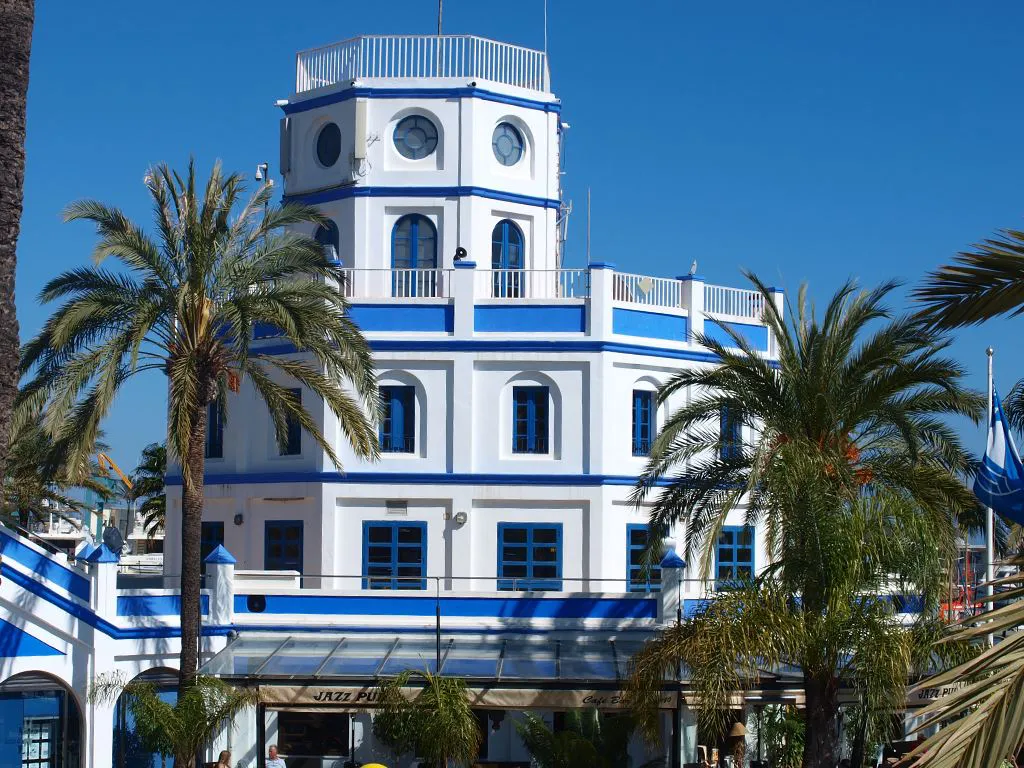
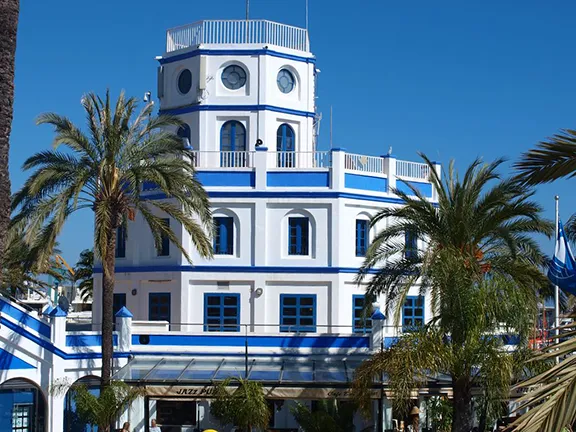
Estepona Marina Tower
From the lighthouse, the pedestrian visitor will have the first view of Puerto Deportivo de Estepona, Estepona marina. Overlooked by its control tower, the marina offers shelter and moorings to a mix of boats from the local fishing craft to luxury sailing and motor cruisers. Estepona has a thriving fish market through which much of the catch is processed daily. Some of the catch then appears on the local supermarket fish counters, some in the local fishmongers or Pescadero and the remainder is loaded into refrigerated wagons destined for supermarkets inland.
The moorings are surrounded on the land side by restaurants offering food from all nations and bars offering refreshments of a liquid sort, all looking out on the deep blue Mediterranean Sea. Beneath the lighthouse nestles the fisherman’s huts where, each Sunday, an ages-long tradition is maintained. Whole families and their many extensions descend for a family reunion and meal. On the menu, fish of course.
At the lighthouse, the paseo turns slightly inland past the bullring. Although there is the very occasional bullfight, the Plaza de Toros is more likely to be hosting a musical concert that can range from heavy rock to classical. Within its walls, the bullring has another internationally acclaimed venue. The Paleontological Museum. Its fame is as a result of the geology of the ancient shore, the sedimentary deposits laid down beneath a shallow sea over a period of millions of years. The sediments, now the alluvial plain behind Estepona, contain the entire evolutionary history of plants, vertebrates and crustaceans from the Pliocene era.
The sediments washed down from a mountain that now shelters the town from northerly winds, Los Reales. Los Reales is sometimes called the ‘Red Mountain’ because that is how it appears some days when the sun reflects just right of the red igneous peridotite of which it is composed. At 1,454 metres Los Reales is 110 metres higher than the highest mountain in the UK, Ben Nevis. Although the clearly visible summit etched against the blue sky is 9 kilometres from the coast at Estepona, the clear Andalucian air creates the optical illusion that it is but a stone’s throw away. For more on the museum, click here.
Those visitors with the stamina continue through the marina and across a stretch of foreshore to reach Cristo Beach. This is a horseshoe-shaped bay just to the west of the marina entrance, with soft sand, sheltered, shallow water and two chirinquitos open Easter until September. This Estepona beach is a firm favourite for families with children. Read more about Playa del Cristo.
One place that could not stand the pressure of the out of town supermarkets is the central market. Situated between the clock tower and the castle it was once a thriving centre, packed with family-owned stalls selling the agricultural produce from the smallholdings surrounding the town, and fish, fresh from the local fishing boats. In the early years of the 21st century. the numbers of stallholders dwindled to just a handful and then, they too, inevitably closed.
The market re-opened in 2018 as a Gourmet Food Market. Now smartly clad waiters and waitresses take orders from the tables inside the airy covered market and the tables outside in the pedestrianised street. The choice of food is huge, produced in the various cubicles set around the inner walls of the old market. In the centre of the hall, diners are faced with a choice of bars selling wines and spirits, cocktails and beer, including a microbrewery. It is a lively setting with lots of ambience, and yet more flowers.
Apart from the food hall, Estepona and its port are packed with places to eat and drink. You will find traditional Andalucian food, fish restaurants and tapas bars in the old town, and international flavours elsewhere.
For those inclined towards shopping, a pedestrian street, Calle Reale, runs parallel to the paseo, intersected by Calle Terraza. On these two streets and the smaller streets off them are many of the major shops in town.
Estepona is still a traditional coastal Spanish town with its roots in agriculture, livestock and fishing. Although it is seeing an increase in foreign tourists it refrains from offering the glitzy night club entertainment that can be had in Puerto Banus or Marbella; the highlight of the week for a visitor at an hotel may be the Friday evening piano recital.
For a family holiday, as the Spanish realised many years ago, it is hard to beat. Good food, brilliant beaches, plenty of places to sit and relax and a real ‘Spanish’ feel to the place. Which is also the reason Estepona is becoming more popular with the expat population that, in 2014, accounted for 33% of the residents.
Looking for a place to stay in Estepona?
Or check out the latest deals in Estepona below!
Booking.comWant to learn more about what to see and do in Estepona? Check out our other articles:
For more about Estepona, click here